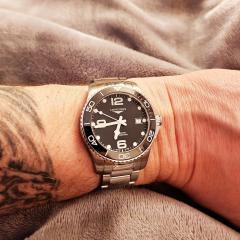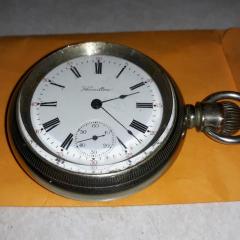Help Identifying
-
Similar Content
-
Recently Browsing
- No registered users viewing this page.
-
Topics
-
Posts
-
The wheels turned fine. I set the escape wheel in the epoxy when it had just ‘skinned’ and wasn’t set, made sure it spun with the 4th wheel, and let it set. After cleaning I assembled the barrel and wheel train - all fine. Moving the barrel the escape wheel spun freely. I put a bit of 9010 in my epoxy setting. It went wrong when I put the pallet fork in. It wasn’t seated right (no jewels) and the escape wheel knocked a pallet jewel out. I have no idea how to reset a pallet jewel - epoxy again? I’m not spending any more time on this one - it’s missing hands and the front half of the case anyway, and I have more watches ready to put on the bench.
-
By RichardHarris123 · Posted
No John, we don't want Mark to change anything, we are just scared of losing a brilliant forum and losing contact with each other. As pointed out, this forum is full of knowledge and I for one, consider the regulars friends. I would hate to lose contact with you and the others. PS, this forum is really important to me. -
one little minor problem with your chemistry experiment here which is what exactly is epilam? In other words is it an exact substance with the chemical you specify or is it a term? For instance originally it was steric acid either dissolved in some sort of solvent or it was applied by vaporizing it. Then now it's all kinds of different things the watch companies all have different ideas there's a whole bunch of patents. So is not always an exact substance. let me snip out a image from the patent that I attached up above. Notice I highlighted something it seems to disagree with your evaluation.
-
By nevenbekriev · Posted
I guess You had to try, as it would be hard to sleep without that try, but, I know the result before the experiment... As I told before, the friction will be so big that the wheel will not turn. The pivots have to be thin and polished - the bigger the number of the wheel (2th, 3gh, 4th...), the thinner the pivot. What You are trying to do is possible, but forming the new thin pivot must be done on lathe. Thus the wheel will get shorter, but can have new pivot without the drilling for normal standard repivoting. Then piece of brass can be soldered under the pivot hole in the bridge and new hole drilled in it to form the new bearing. Well, this way is not the recommended one, not quite correct, but it is possible to do for the excersize... When I say lathe, lathe may be verry simple, someting like turns, but made of what one has in reach of his hands. If You want to try, I will try to guide -
yes by all means let's gather up our weapons tar feathers find the nearest tree in case Mark is not agreeable to our terms on our demands and storm his Castle. I don't quite understand what you're trying to do here? In other words you want Mark to somehow guarantee that the group will live on forever no matter what? You want Mark to somehow change his business model of what is trying to do or should we just take the group away from him? oh and is quite possible that Mark never realized that his discussion group would take on a life of its own. That the members of the group would like to continue on forever.
-








Recommended Posts
Join the conversation
You can post now and register later. If you have an account, sign in now to post with your account.
Note: Your post will require moderator approval before it will be visible.